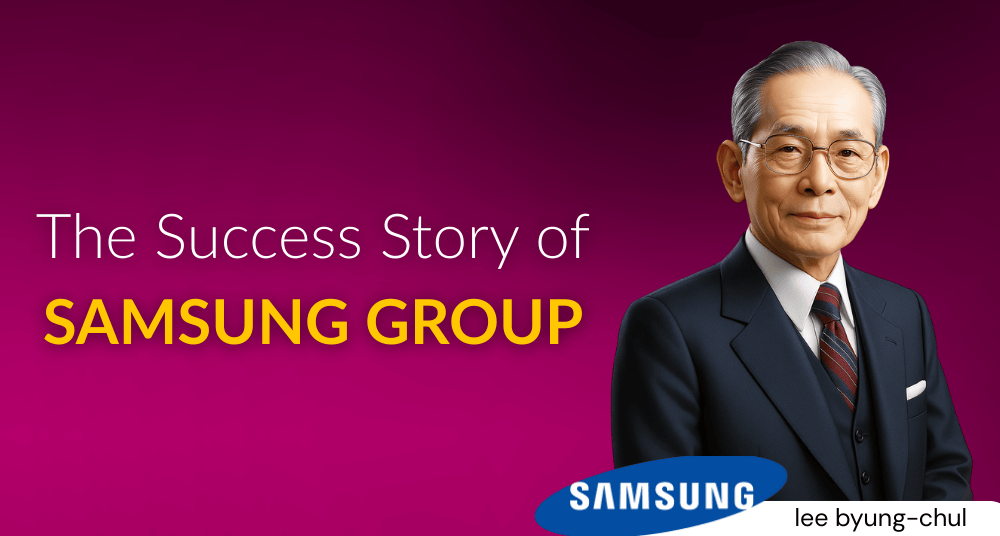Samsung Group, founded in 1938 by Lee Byung-chul, has transformed from a small trading company into a global technology powerhouse. This journey is a testament to strategic diversification, innovation, and adaptability. Here’s an in-depth look at Samsung’s evolution and its impact on the global market.
Samsung Group Early Beginnings: 1938–1960s
Samsung’s inception was modest. Lee Byung-chul started the company in Su-dong (now Ingyo-dong), South Korea, dealing in dried fish, locally-grown groceries, and noodles. The name “Samsung” translates to “three stars” in Korean, symbolizing greatness, strength, and eternity Wikipedia.
In the 1950s, Samsung expanded into textiles and food processing. By 1969, Samsung established Samsung Electric Industries, marking its entry into the electronics industry. This move was pivotal, setting the stage for future technological advancements Wikipedia.
Expansion into Electronics and Semiconductors: 1970s–1980s
The 1970s saw Samsung’s foray into electronics. In 1974, it acquired Korea Semiconductor, leading to the establishment of Samsung’s semiconductor division. This strategic move positioned Samsung as a key player in the semiconductor industry Wikipedia.
By the 1980s, Samsung had developed its first black-and-white television set and ventured into the semiconductor business, producing memory chips that would become integral to its product lineup.
Globalization and Innovation: 1990s–2000s
The 1990s marked Samsung’s aggressive push into global markets. It introduced the world’s first 64MB DRAM in 1992, followed by 256MB DRAM in 1994, and 1GB DRAM in 1996. These innovations solidified Samsung’s reputation as a leader in memory technology Wikipedia.
In the 2000s, Samsung expanded its product range to include smartphones, televisions, and home appliances. The launch of the Galaxy smartphone series in 2009 was a game-changer, propelling Samsung into the global smartphone market.
Strategic Acquisitions and Diversification: 2010s–Present
Samsung’s growth strategy included strategic acquisitions. In 2016, it acquired Harman International for $8 billion, enhancing its capabilities in connected car technology and audio systems. More recently, in 2025, Samsung, through Harman, acquired Sound United, adding premium audio brands like Bowers & Wilkins, Denon, and Marantz to its portfolio The Verge.
Additionally, Samsung’s “Make for India” initiative, launched in 2018, involved opening the world’s largest mobile factory in Noida, India. This move not only boosted local manufacturing but also aligned with India’s “Make in India” vision, enhancing Samsung’s presence in the region Young Urban Project.
Leadership and Corporate Structure
Samsung operates as a conglomerate with diverse subsidiaries, including Samsung Electronics, Samsung Heavy Industries, and Samsung Life Insurance. The company remains a family-run business, with the Lee family playing a central role in leadership. Lee Jae-yong, the grandson of founder Lee Byung-chul, currently serves as the de facto leader of Samsung Wikipedia.
Challenges and Resilience
Samsung has faced its share of challenges. The 2016 Galaxy Note 7 recall due to battery issues was a significant setback. However, Samsung’s swift response and commitment to quality control helped restore consumer trust.
In 2025, Samsung announced plans to expand its Galaxy AI system to 400 million devices worldwide by the end of the year, demonstrating its commitment to integrating artificial intelligence across its product lineup The Times of India.
Future Outlook
Looking ahead, Samsung is focusing on several key areas:
- Artificial Intelligence: Expanding Galaxy AI integration across devices.
- Semiconductors: Advancing memory technology to meet growing demand.
- Sustainability: Committing to carbon neutrality by 2050.
Samsung’s ability to innovate and adapt positions it well for continued success in the global market.
FAQs
Q1: Who founded Samsung?
A1: Samsung was founded by Lee Byung-chul in 1938 as a trading company in South Korea.
Q2: What does “Samsung” mean?
A2: “Samsung” translates to “three stars” in Korean, symbolizing greatness, strength, and eternity.
Q3: When did Samsung enter the electronics industry?
A3: Samsung entered the electronics industry in 1969 with the establishment of Samsung Electric Industries.
Q4: What are some of Samsung’s major acquisitions?
A4: Notable acquisitions include Harman International in 2016 and Sound United in 2025.
Q5: What is Samsung’s “Make for India” initiative?
A5: Launched in 2018, this initiative involved opening the world’s largest mobile factory in Noida, India, to boost local manufacturing.
Samsung’s journey from a small trading company to a global tech giant exemplifies the power of strategic diversification, innovation, and adaptability. As it continues to evolve, Samsung remains a formidable force in the global technology landscape.






What do you think?
It is nice to know your opinion. Leave a comment.